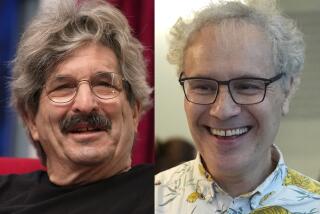3 U.S. Scientists Win Nobel Medicine Prize
- Share via
Three Americans, including a UCLA pharmacologist, were awarded the 1998 Nobel Prize for Physiology or Medicine on Monday for their discovery that nitric oxide--a common gas better known as an air pollutant--transmits signals within the human body.
That discovery led to the development of the anti-impotence drug Viagra, to a new treatment for newborns with dangerously high blood pressure in their lungs and to drugs for the treatment of shock. It is also expected to stimulate the development of new drugs for heart disease and perhaps cancer.
UCLA’s Louis J. Ignarro, 57, will share the $955,500 prize with Robert F. Furchgott, 82, of the State University of New York in Brooklyn and Dr. Ferid Murad, 62, of the University of Texas medical school in Houston.
“The discovery of nitric oxide and its function is one of the most important in the history of cardiovascular medicine,” said Dr. Valentin Fuster, president of the American Heart Assn. “It has allowed us to improve the treatment of certain patients” and will probably lead to the discovery of new ways to treat high blood pressure and heart attacks, he added.
The newly discovered signaling role of nitric oxide has “unprecedented ramifications,” added Dr. Jonathan Stamler of the Duke University Medical Center. “It influences the function of virtually every organ system in the body,” he said.
Ignarro received the news in Naples, Italy, while traveling. UCLA colleague Dr. Robin Eisner told him he had received the prize, and Ignarro asked whether the call was a prank.
At a news conference in Naples, he said, “From tomorrow on, my life won’t be changed, but my devotion to research will be redoubled. I have devoted a great part of my labor to this molecule . . . and now, finally, this discovery can be put to use in the treatment of numerous pathologies.”
Colleagues and friends at UCLA celebrated Monday with an impromptu party in Ignarro’s laboratory. “We were hoping he would win it,” said Dr. Gerald Leavey, dean of the UCLA School of Medicine. “We thought he had a strong chance to win. It’s very well deserved.”
Students were also pleased that the popular instructor had been honored. “I am really impressed by his ability to engage students with clarity, brilliance and humor,” said UCLA medical student Craig Kuhns. “He’s an excellent teacher”--as witnessed by the fact that he has received 10 Golden Apple Awards from the medical students for teaching proficiency.
Murad, whose father was an Albanian immigrant, was also gratified by the award.
“It’s sort of the culmination of your career,” he said. “You work and work and work and hope that what you are doing is important and will do some significant things for mankind and be recognized by your fellow scientists. When it happens, it is incredible.”
Furchgott, who is retired but comes into his laboratory every day, said, “I am somewhat surprised, although I knew my name was up for the prize this year. I guess I had some good friends voting.”
‘An Entirely New Principle’
The discovery that nitric oxide produced by one cell could alter the function of other cells “represents an entirely new principle for signaling in biological systems,” according to the Nobel Assembly, which selects recipients of the prize.
Previously known signaling agents were typically complex molecules that must bind to specific receptors in cell membranes to effect a response. But nitric oxide is a light gas “that can pass through membranes like they aren’t even there,” said neurobiologist Erin Margaret Schuman of Caltech, causing chemical changes directly in the interior of cells.
Murad studied how nitroglycerin and other drugs used to dilate blood vessels functioned. He discovered in 1977 that they promoted the release of nitric oxide. Although he speculated that hormones produced by the body might also act by releasing nitric oxide, there was no experimental evidence to support that possibility.
Furchgott examined the effects of such naturally occurring chemicals as acetylcholine on blood vessels and, in 1980, concluded that they stimulated the release of a signaling molecule that caused muscles of the blood vessels to relax. He called this signaling agent EDRF, but did not know its chemical composition.
Ignarro, working both independently and with Furchgott, demonstrated that EDRF was, in fact, nitric oxide. When Furchgott and Ignarro presented their conclusions at a conference in 1986, the assembly said, “it elicited an avalanche of research activities in many different laboratories around the world.” By the end of 1992, so many new results had appeared that the journal Science named nitric oxide the “Molecule of the Year.”
Drugs that stimulate release of nitric oxide in the penis, such as Viagra, increase blood flow, leading to erections. Researchers hope that similar drugs that would relax blood vessels throughout the body could improve blood flow and reduce hypertension. Other potential drugs might be used to increase blood flow through clogged or blocked arteries.
The discovery also allows physicians to treat persistent pulmonary hypertension of the newborn, a breathing disorder that can be fatal. Allowing the infants to breath trace amounts of nitric oxide causes blood vessels in their lungs to relax so the infants can breathe normally.
Too much nitric oxide can be a problem, however. White blood cells produce the gas to kill microorganisms during an infection. In a massive infection, however, they produce so much nitric oxide that blood vessels throughout the body dilate dramatically, producing fatal shock. To treat such shock, physicians now use drugs that block nitric oxide production.
Monday’s prize announcement has a curious link to Alfred Nobel, who invented dynamite by combining nitroglycerin--which is normally very unstable--with kieselguhr, a porous soil rich in the shells of diatoms. That safe explosive produced the fortune that allowed him to endow the Nobel prizes.
When Nobel developed heart disease late in life, his doctors prescribed nitroglycerin. Knowing that it produced headaches and not believing that it could reduce chest pain, he refused to take it.
Now, more than 100 years later, the Nobel Assembly concluded, events have come full circle with the demonstration that nitroglycerin acts by releasing nitric oxide gas.
(BEGIN TEXT OF INFOBOX / INFOGRAPHIC)
Better Blood Flow
Discoveries about nitric oxide by three pharmacologists have won the Nobel Prize in Physiology or Medicine. Nitric oxide increases the diameter of blood vessels. Drugs that stimulate its release are used to treat impotence and could help treat hypertension.
*
Hormonal messenger binds to receptor on vessel’s interior.
*
Messenger signals cells to release nitric oxide.
*
Nitric oxide causes artery walls to relax, increasing the vessel’s diameter.
More to Read
Sign up for Essential California
The most important California stories and recommendations in your inbox every morning.
You may occasionally receive promotional content from the Los Angeles Times.










